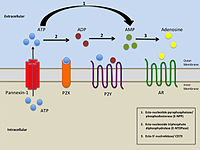
Photo from wikipedia
Caffeine is a regular part of the diet of many adults (coffee, tea, soft drinks, and energy drinks). Multiple molecular effects of caffeine suggest that it may promote bone loss.… Click to show full abstract
Caffeine is a regular part of the diet of many adults (coffee, tea, soft drinks, and energy drinks). Multiple molecular effects of caffeine suggest that it may promote bone loss. Given the extensive consumption of caffeine worldwide, any impact of caffeine consumption on bone strength and/or density would have large population health implications. The most well-established pharmacological effect of caffeine is non-specific antagonism of adenosine receptors. Adenosine regulates bone metabolism in a complex manner, with in vitro studies suggesting that direct stimulation of adenosine A 2A and A 2B receptors induces bone formation by activating osteoblasts and suppressing osteoclast differentiation and function. Thus, competitive inhibition of adenosine A 2 receptors by caffeine may inhibit bone formation and promote bone resorption. However, antagonism of adenosine A 1 receptors may have opposing effects. Caffeine has also been suggested to affect bone through derangement of calcium metabolism, alteration of vitamin D responses, and other mechanisms. In clinical and population-based studies, the impact of caffeine consumption on bone metabolism offers a mixed picture, with some but not all studies suggesting a potential link between caffeine intake and reduced bone mineral density or increased fracture risk. Differences in methodology, selected populations, and duration/timing of the studies may account for study outcome discrepancies. The in vitro effects of caffeine on cells involved in bone metabolism suggest that caffeine intake may promote osteoporosis, and some but not all clinical studies support a modest adverse caffeine impact. Herein, we describe the basic biology of caffeine as it pertains to bone, review the clinical literature to date, and consider the implications of the current data on clinical practice and future studies.
Journal Title: Osteoporosis International
Year Published: 2022
Link to full text (if available)
Share on Social Media: Sign Up to like & get
recommendations!